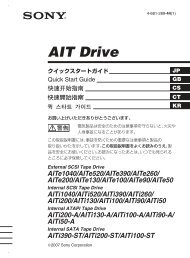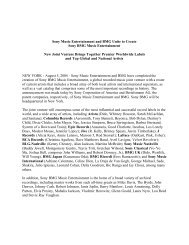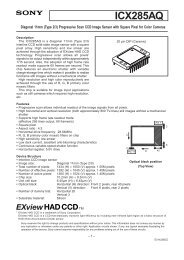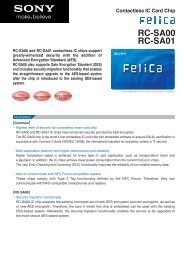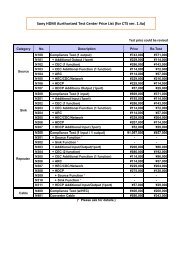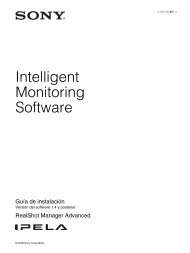PDF [4833KB] - Sony
PDF [4833KB] - Sony
PDF [4833KB] - Sony
You also want an ePaper? Increase the reach of your titles
YUMPU automatically turns print PDFs into web optimized ePapers that Google loves.
the amortization of deferred insurance acquisition<br />
costs in the Financial Services segment are<br />
expected to decrease, total expenses for depreciation<br />
and amortization in the Electronics<br />
and Game segments are expected to increase.<br />
RESEARCH AND DEVELOPMENT<br />
<strong>Sony</strong> expects research and development costs<br />
(total of expenses for the development of new<br />
product prototypes and expenses for the development<br />
of mid- to long-term new technologies)<br />
for the fiscal year ending March 31, 2005<br />
to be 550 billion yen, a 7 percent increase<br />
compared with the fiscal year ended March<br />
31, 2004. Research and development costs<br />
associated with process technologies, including<br />
those technologies used in the Game segment,<br />
which were previously recorded in the Game<br />
segment, will be recorded in the Electronics<br />
segment from the fiscal year ending March 31,<br />
2005, due to the integration of the semiconductor<br />
businesses in the Electronics and Game<br />
segments. As a result, research and development<br />
costs in the Electronics segment are expected<br />
to increase more than 10 percent<br />
compared with the 429.4 billion yen recorded<br />
in the previous year. On the other hand, in the<br />
Game segment, overall research and development<br />
costs are expected to decrease by only<br />
10 percent compared to the 83.4 billion yen<br />
recorded in the previous year. The relatively<br />
small decrease is due to the fact that, although<br />
research and development costs associated<br />
with process technologies will decrease, research<br />
and development costs associated with<br />
next generation semiconductor design, new<br />
platforms such as the PSP and software are<br />
expected to increase.<br />
CRITICAL ACCOUNTING POLICIES<br />
The preparation of the consolidated financial<br />
statements in conformity with U.S. GAAP<br />
requires management to make estimates and<br />
assumptions that affect the reported amounts<br />
of assets and liabilities, disclosure of contingent<br />
assets and liabilities at the date of the<br />
financial statements and the reported amounts<br />
of revenues and expenses during the reporting<br />
period. On an ongoing basis, <strong>Sony</strong><br />
evaluates its estimates which are based on<br />
historical experience and on various other<br />
assumptions that are believed to be reasonable<br />
under the circumstances. The results of<br />
these evaluations form the basis for making<br />
judgments about the carrying values of assets<br />
and liabilities and the reported amounts of<br />
expenses that are not readily apparent from<br />
other sources. Actual results may differ from<br />
these estimates under different assumptions.<br />
<strong>Sony</strong> considers an accounting policy to be<br />
critical if it is important to its financial condition<br />
and results, and requires significant<br />
judgments and estimates on the part of<br />
management in its application. <strong>Sony</strong> believes<br />
that the following represent the critical<br />
accounting policies of the company.<br />
INVESTMENTS<br />
<strong>Sony</strong>’s investments are comprised of debt and<br />
equity securities accounted for under both the<br />
cost and equity method of accounting. If it has<br />
been determined that an investment has sustained<br />
an other-than-temporary decline in its<br />
value, the investment is written down to its fair<br />
value by a charge to earnings. <strong>Sony</strong> regularly<br />
evaluates its investment portfolio to identify<br />
other-than-temporary impairments of individual<br />
securities. Factors that are considered by<br />
<strong>Sony</strong> in determining whether an other-thantemporary<br />
decline in value has occurred include:<br />
the length of time and extent to which the<br />
market value of the security has been less<br />
than its original cost, the financial condition,<br />
operating results, business plans and estimated<br />
future cash flows of the issuer of the security,<br />
other specific factors affecting the market value,<br />
deterioration of credit condition of the issuers,<br />
sovereign risk, and ability to retain the investment<br />
for a period of time sufficient to allow<br />
for the anticipated recovery in market value.<br />
In evaluating the factors for available-for-sale<br />
securities whose fair values are readily determinable,<br />
management presumes a decline in<br />
value to be other-than-temporary if the fair<br />
value of the security is 20 percent or more<br />
below its original cost for an extended period<br />
of time (generally a period of up to six to twelve<br />
months). This criteria is employed as a threshold<br />
to identify securities which may have a decline<br />
in value that is other-than-temporary. The presumption<br />
of an other-than-temporary impairment<br />
in such cases may be overcome if there is<br />
evidence to support that the decline is temporary<br />
in nature due to the existence of other<br />
factors which overcome the duration or magnitude<br />
of the decline. On the other hand, there<br />
may be cases where impairment losses are<br />
recognized when the decline in the fair value<br />
of the security is not more than 20 percent or<br />
such decline has not existed for an extended<br />
period of time, as a result of considering specific<br />
factors which may indicate the decline in the<br />
fair value is other-than-temporary.<br />
The assessment of whether a decline in the<br />
value of an investment is other-than-temporary<br />
often requires management judgment based<br />
on evaluation of relevant factors. Those factors<br />
include business plans and future cash flows<br />
of the issuer of the security, the regulatory,<br />
economic or technological environment of the<br />
investee, and the general market condition of<br />
either the geographic area or the industry in<br />
which the investee operates. Accordingly, it is<br />
possible that investments in <strong>Sony</strong>’s portfolio<br />
that have had a decline in value that are currently<br />
believed to be temporary may determine<br />
to be other-than-temporary in the future<br />
based on <strong>Sony</strong>’s evaluation of additional information<br />
such as continued poor operating<br />
results, future broad declines in value of<br />
worldwide equity markets or circumstances in<br />
market interest rate fluctuations. As a result,<br />
unrealized losses recorded for investments may<br />
be recognized into income in future periods.<br />
IMPAIRMENT OF LONG-LIVED ASSETS<br />
<strong>Sony</strong> reviews the carrying value of its longlived<br />
assets held and used and long-lived assets<br />
to be disposed of whenever events or changes<br />
in circumstances indicate that the carrying value<br />
of the assets may not be recoverable. This<br />
review is performed using estimates of future<br />
cash flows by product category (e.g. TV display<br />
CRTs) or entity (e.g. semiconductor manufacturing<br />
division in the U.S.). If the carrying value<br />
of the asset is considered impaired, an impairment<br />
charge is recorded for the amount by<br />
which the carrying value of the asset exceeds<br />
its fair value. Fair value is determined using the<br />
present value of estimated net cash flows or<br />
comparable market values.<br />
Management believes that the estimates of<br />
future cash flows and fair value are reasonable;<br />
however, changes in estimates resulting in<br />
lower future cash flows and fair value due to<br />
84


![PDF [4833KB] - Sony](https://img.yumpu.com/26420643/86/500x640/pdf-4833kb-sony.jpg)
